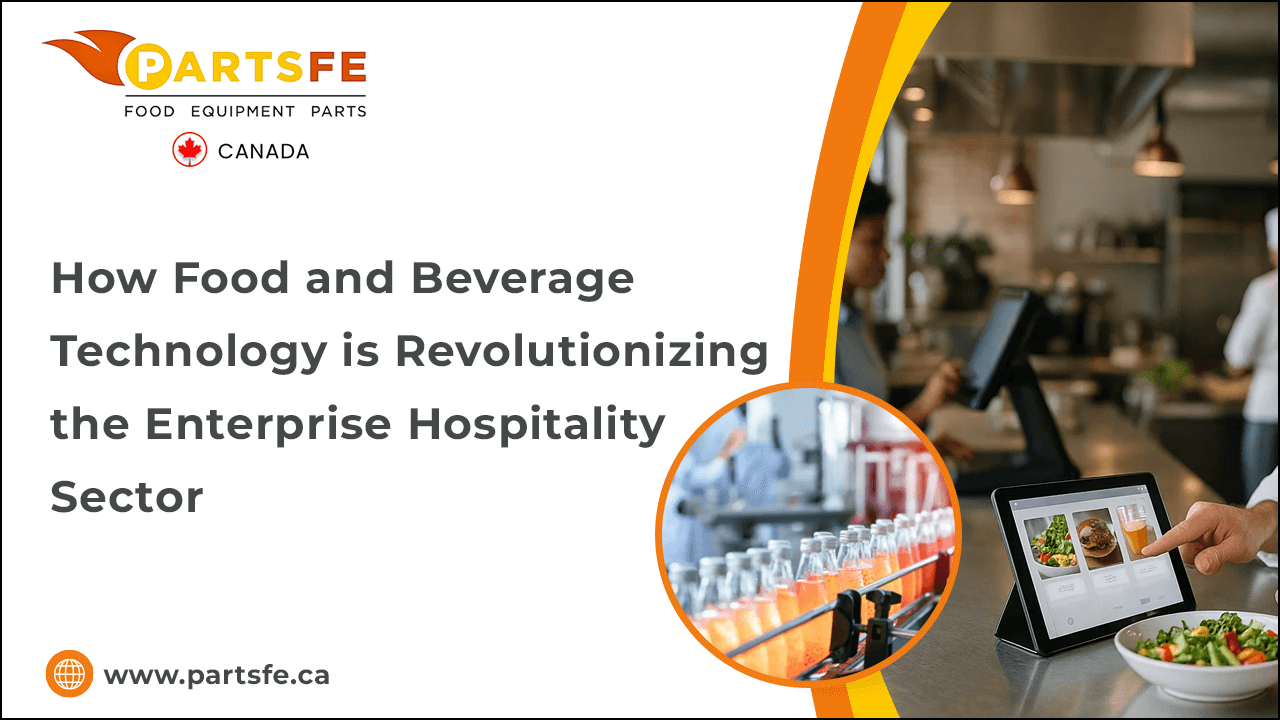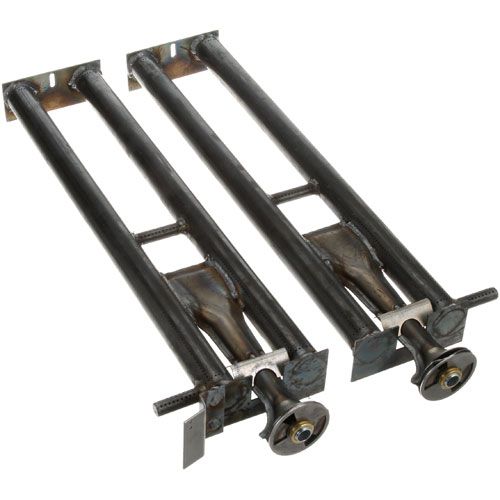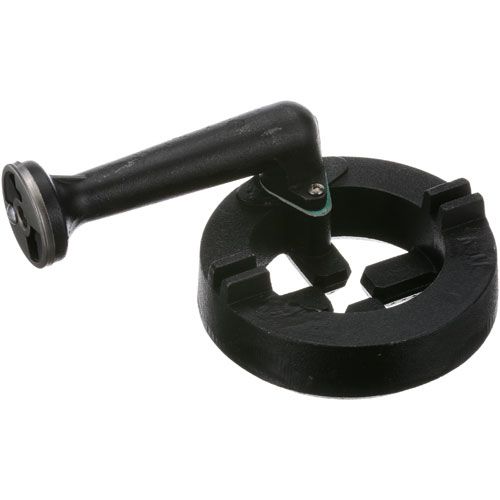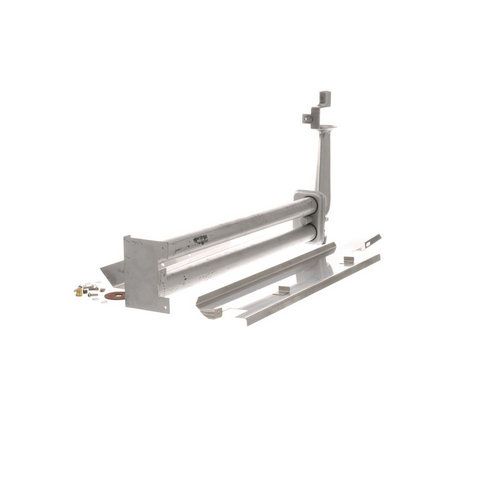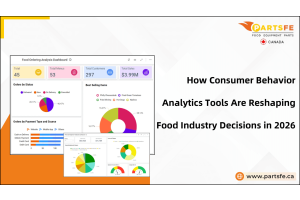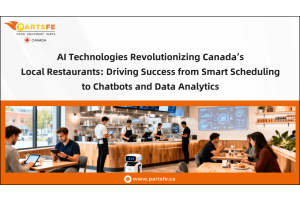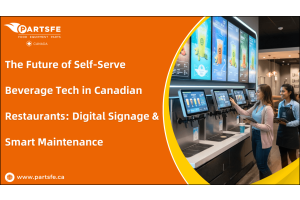How Food and Beverage Technology is Revolutionizing the Enterprise Hospitality Sector
Food and beverage technology is rapidly transforming the enterprise hospitality sector, introducing innovative solutions that enhance efficiency and elevate guest experiences. From automated ordering systems and smart kitchen appliances to advanced inventory management and contactless payments, technology is streamlining operations and reducing costs for large-scale hospitality businesses. These advancements help enterprises stay competitive in a fast-evolving market while meeting the growing demands of tech-savvy customers.
Moreover, food and beverage technology plays a crucial role in ensuring food safety, quality control, and sustainability. With real-time data analytics and IoT-enabled devices, hospitality enterprises can monitor supply chains, reduce waste, and maintain high standards. As a result, the integration of cutting-edge technology is not only revolutionizing service delivery but also driving operational innovation across the entire hospitality industry.
The Growing Importance of Food and Beverage Technology in Hospitality
As the hospitality sector evolves, food and beverage technology is driving innovation beyond traditional improvements. These unique advancements are shaping the future of the industry in remarkable ways:
AI-Powered Flavor Profiling
Artificial intelligence is being used to analyze customer taste preferences and suggest unique menu combinations, enhancing personalized dining experiences.
Example:
-
The Rec Room (Toronto) uses AI to suggest personalized menu options based on guest preferences.
-
EatLove (Montreal) utilizes AI to create personalized meal plans tailored to individual dietary restrictions.
-
Sodo (Vancouver) employs AI to recommend wine pairings based on diners' individual tastes and past orders.
Blockchain for Transparency
Blockchain technology ensures traceability of ingredients, allowing guests to verify the origin and ethical sourcing of their food in real-time.
Example:
-
Loblaws (through George Weston Limited) uses blockchain to trace the origin of food items like seafood.
-
Cascades (Quebec) employs blockchain technology to track the sustainable sourcing of paper products.
-
Ritual (Toronto) uses blockchain to allow customers to trace the origin of their food and ensure ethical sourcing.
Robotics in Food Presentation
Robots are not only preparing food but also creatively plating dishes, adding a futuristic and visually engaging element to dining.
Example:
-
Spyce in Toronto uses robots in its kitchen for food prep and presentation, enhancing both speed and presentation.
-
Robotic Kitchens at the University of Calgary feature robots that prepare meals in the campus dining halls.
-
The Kettleman’s Bagel Co. (Toronto) employs robots for the automated preparation and creative plating of bagels.
Smart Allergen Detection
Portable devices and sensors can detect allergens instantly, protecting guests with dietary restrictions and boosting trust in hospitality venues.
Example:
-
Allergen Check, a Canadian startup, uses portable allergen detection devices that can scan food for hidden allergens.
-
The Gluten-Free Garage (Toronto) is dedicated to offering safe, certified gluten-free food using testing devices to ensure allergen-free meals.
-
Winners (Ontario) has introduced handheld allergen detectors at select locations to ensure food safety for customers with allergies.
Augmented Reality (AR) Dining
AR apps allow customers to visualize dishes in 3D before ordering, making menu selection more interactive and informative.
Example:
-
The Keg Steakhouse & Bar (Toronto) has experimented with AR menus to help customers visualize their meals before ordering.
-
Scena Restaurant (Vancouver) integrates AR to give diners a detailed 3D experience of their dishes, improving their decision-making process.
-
RestoApp (Quebec) offers customers an AR-powered experience to view their meal in 3D before they make their selection.
Zero-Waste Tech
Innovative systems convert food scraps into energy or compost on-site, helping venues drastically reduce their environmental footprint.
Example:
-
The Green Table (Vancouver) uses a system to convert food scraps into compost for local farms.
-
Save-on-Foods (British Columbia) employs a food-waste-reduction system that converts kitchen scraps into biogas energy.
-
Barburrito (Toronto) utilizes food-waste-reduction technologies to repurpose organic waste into energy and fertilizers.
Mood-Based Beverage Customization
Technology that reads guests' biometric data to craft drinks that match their mood or health needs, providing a truly personalized service.
Example:
-
Hapa Izakaya (Vancouver) uses an app that reads guest preferences to recommend customized cocktails.
-
The Mindful Mixologist (Toronto) experiments with crafting drinks tailored to guests' moods using wellness sensors.
-
The Cocktail Lab (Ottawa) offers a mood-based drink experience where cocktails are tailored to the customer’s emotional state using biometric sensors.
These technologies are redefining hospitality, making food and beverage services more transparent, personalized, and sustainable than ever before.
Why Food and Beverage Innovation Matters for Enterprise Hospitality
In enterprise hospitality, where scale and diversity define success, food and beverage innovation is a game-changer. It empowers large organizations to adapt quickly, delight customers, and optimize complex operations.
Cloud-Based Recipe Management
Centralized digital recipe platforms enable consistent food preparation and quick updates across all locations, minimizing errors and improving training.
Example:
-
Compass Group in Canada uses cloud-based recipe management systems to ensure consistency across its diverse portfolio of restaurants.
-
Marriott uses Katanacook to centralize recipe databases, making it easier for kitchens to standardize and quickly update menus.
Integrated Multi-Channel Ordering
Seamless integration of in-house dining, room service, mobile apps, and third-party delivery platforms enhances customer convenience and expands revenue streams.
Example:
-
Fairmont Hotels integrates room service with mobile apps and third-party platforms like Uber Eats for an efficient ordering experience.
-
The Sutton Place Hotel in Vancouver uses a unified ordering system, streamlining the guest experience from dining rooms to delivery.
Predictive Inventory Management
Innovative software forecasts demand based on trends, events, and historical data, reducing overstocking and preventing shortages across multiple outlets.
Example:
-
Loblaws uses predictive analytics to manage food inventory in its restaurants, avoiding food waste while maintaining stock levels.
-
Earls Kitchen + Bar leverages advanced software to predict ingredient needs and optimize stock across its locations nationwide.
Cross-Outlet Collaboration
Centralized innovation hubs within enterprises foster collaboration between kitchens, encouraging shared creativity and standardized adoption of successful menu innovations.
Example:
-
Toronto’s Four Seasons Hotel has a centralized R&D kitchen, allowing chefs to collaborate on new recipes and share ideas across global locations.
-
Tim Hortons has innovation labs where chefs and product developers collaborate to create new menu items that are tested across multiple locations.
Virtual Culinary Labs
Enterprise-scale virtual reality kitchens enable chefs to experiment with new recipes and training without physical resource constraints.
Example:
-
The Culinary Institute of Canada offers VR cooking classes, allowing students and enterprise chefs to practice cooking in virtual environments.
-
Marriott uses VR culinary labs for global training, allowing chefs to experience different cuisines without needing a full kitchen setup.
Automated Quality Control
Cutting-edge sensors and AI monitor cooking processes and ingredient quality across outlets, ensuring every dish meets enterprise standards without manual oversight.
Example:
-
Restaurant Brands International (parent company of Tim Hortons) uses AI-powered sensors to ensure consistency in food preparation across all its locations.
-
Fairmont uses automated quality control systems in kitchens to monitor temperatures, portion sizes, and cooking times, maintaining consistent quality.
Immersive Guest Experiences
Innovations like multisensory dining (combining sound, lighting, and aroma tech) create memorable experiences that elevate brand loyalty at flagship properties.
Example:
-
Eau De Vie (Toronto) uses ambient lighting, sound, and scent to create an immersive dining experience for guests.
-
The Shangri-La Hotel in Vancouver incorporates multisensory dining technology to enhance the guest experience with curated lighting and scent during meals.
By embracing these innovations, enterprise hospitality not only enhances operational efficiency but also builds deeper, more meaningful connections with guests at every touchpoint.
Why Innovation is Crucial for Enterprise Hospitality Success
Innovation is the backbone of success in the enterprise hospitality sector, where scale and complexity demand smart solutions to enhance efficiency, sustainability, and guest satisfaction. Key innovations shaping this success include:
Robotic Sous-Chefs
Advanced robots assist chefs by handling complex cooking tasks such as flipping, seasoning, and performing quality checks, increasing kitchen precision and reducing labor strain.
Example: Canadian Burger King locations use robotic arms for grilling burgers and flipping patties, ensuring precision and consistency during high-volume hours.
3D Food Printing
This cutting-edge technology enables the creation of customized food shapes, intricate garnishes, and plant-based protein alternatives on demand, offering unique menu possibilities and personalized dining experiences.
Example: Top Chef (Toronto) utilizes 3D food printing to create intricate dessert sculptures and customized garnishes for upscale dining experiences at its exclusive events.
Energy Harvesting Appliances
Innovative kitchen equipment recycles heat or kinetic energy to partially power itself, significantly improving energy efficiency in large-scale operations.
Example: McDonald's (Ontario) has started testing energy-harvesting fryers that recycle cooking heat to power other kitchen appliances, lowering energy use.
Smart Supply Chain Ecosystems
Real-time data sharing among suppliers, distributors, and kitchens optimizes procurement processes, enhances delivery accuracy, and boosts overall supply chain agility.
Example: Metro Inc. (Quebec) integrates smart sensors into its distribution network to track ingredient quality and improve delivery accuracy, ensuring product freshness.
Biodegradable Smart Packaging
Packaging embedded with freshness sensors tracks product quality even after delivery, ensuring food freshness while supporting eco-friendly practices.
Example: Planta (Toronto) uses biodegradable packaging with built-in sensors to track the quality of its plant-based meal delivery, reducing food waste and ensuring sustainability.
Adaptive Dining Environment Controls
Automated lighting and temperature systems adjust dynamically to enhance the dining atmosphere, influencing guests' mood and appetite positively.
Example: The Fairmont Banff Springs Hotel (Alberta) utilizes adaptive lighting and sound systems in its dining rooms to create a personalized dining ambiance for each guest.
Cloud-Powered Collaborative Menu Platforms
These platforms enable chefs across multiple locations to share feedback, experiment, and co-create menu innovations swiftly and efficiently.
Example: East Side Mario's (Canada) employs a cloud-based platform to allow chefs across its network of restaurants to collaborate on seasonal menus and track customer preferences in real-time.
Real-Time Waste Analytics
Advanced sensors monitor food waste at every stage, allowing immediate corrective action and targeted waste reduction, which improves sustainability and cost-efficiency.
Example: Oliver & Bonacini (Toronto) integrates real-time waste monitoring technology in their kitchens to analyze food waste patterns and optimize portion sizes, reducing food costs and environmental impact.
Embracing these innovations empowers enterprise hospitality businesses to stay agile, deliver exceptional guest experiences, and meet evolving market demands effectively.
Explore this article on emerging trends in Canadian hospitality: what’s shaping the industry in 2025 for key innovations, shifting consumer preferences, and tech-driven transformations redefining the guest experience.
Challenges Driving Technology Adoption in Food and Beverage Hospitality
Food and beverage technology is transforming hospitality, but its adoption comes with several key challenges. Addressing these obstacles is crucial for successful implementation and growth.
|
Challenges |
Description |
Tech-Driven Solutions |
|
Complex Integration with Legacy Food & Beverage Systems |
Incompatibility between old kitchen equipment and new smart devices leads to data silos. Lack of real-time synchronization between procurement, inventory, and kitchen systems causes inefficiencies. Difficulties in maintaining consistent guest experiences across disparate technology platforms. |
Unified API ecosystems enable seamless data exchange between legacy and new systems. Edge computing devices ensure real-time system responsiveness. AI-based middleware synchronizes data from various kitchen equipment. |
|
High Upfront Costs of Food & Beverage Technology |
Enterprise-scale deployment requires costly customization and integration efforts. Difficult to quantify long-term cost savings before technology is fully implemented. The risk of technology obsolescence causes hesitation in committing large budgets. |
Modular kitchen tech solutions allow gradual scaling of capital investment. AI-driven cost-benefit simulation tools help justify investment. Cloud-native platforms minimize obsolescence with regular upgrade |
|
Workforce Training and Adaptation in Food & Beverage Tech |
High turnover in hospitality increases the need for ongoing, efficient staff training. Technological complexity can overwhelm staff, reducing morale and productivity. Cultural resistance to automation is perceived as job replacement |
Gamified training apps for kitchen and service staff. AI-powered virtual assistants embedded in kitchen equipment. Collaborative robotics (cobots) to assist chefs, promoting teamwork. |
|
Managing Food & Beverage Data Accuracy and Security |
Massive volume and variety of food-related data increase the risk of errors. Multiple access points for data create vulnerabilities to cyberattacks. Compliance requirements demand detailed data audit trails. |
Blockchain-enabled provenance tracking for ingredient sourcing. IoT sensor networks automate food quality and safety data capture. AI-based anomaly detection systems flag irregularities in data. |
|
Food Safety Compliance Using New Technologies |
Dynamic regulatory environments require rapid adjustments to food safety processes. Manual compliance tracking is error-prone and time-consuming. Ensuring consistent food safety across multi-site operations is difficult without standardized tech. |
Smart kitchen appliances with built-in compliance checks (auto temperature controls). Cloud-based compliance platforms that update protocols based on regional regulations. Wearable sensors monitor hygiene compliance (e.g., hand washing). |
|
Balancing Menu Customization with Standardized Quality |
Increased demand for dietary customization complicates kitchen workflows. Maintaining portion control and consistency of taste across customized orders is challenging at scale. Integrating customer preferences from multiple ordering channels into kitchen systems. |
AI-driven recipe adaptation engines modify ingredient proportions based on customization. Automated portion control dispensers ensure precise ingredient delivery. Integrated omnichannel ordering platforms consolidate customer preferences. |
|
Sustainability Integration in Food & Beverage Technology |
Difficulty quantifying environmental impact reduction from technology adoption. Complex logistics in sourcing and tracking sustainable ingredients. Balancing sustainability goals with cost and operational efficiency. |
AI-powered sustainability dashboards provide real-time insights into energy and waste metrics. Blockchain platforms verify and certify sustainable ingredient sources. Smart composting and biogas units convert waste into energy or fertilizer |
Check out this article on the future of dining: how digital menu boards are transforming restaurants to learn how they're revolutionizing customer engagement, order accuracy, and operational efficiency.
Final Thoughts
Food and beverage technology is transforming the enterprise hospitality sector by driving efficiency, enhancing guest experiences, and fostering sustainability. From AI-powered personalization to smart supply chains and automation, these innovations help businesses stay competitive in an evolving market while meeting customer demands for quality and transparency.
By embracing technology thoughtfully and fostering strong collaboration with providers, hospitality enterprises can overcome adoption challenges and unlock lasting value. Whether large or small, integrating advanced food tech not only optimizes operations but also strengthens brand loyalty and supports a more sustainable future in hospitality.
Looking for top-quality food and beverage equipment? PartsFe CA offers replacement parts such as commercial mixers, blast chillers, or coffee machines from industry-leading brands Hobart, Scotsman, and Robot Coupe to keep your kitchen running smoothly. Upgrade your hospitality business with durable equipment and expert support from PartsFe CA today!
References:
https://www.nist.gov/
https://restaurant.org/
https://www.nasda.org/
FAQs
Why is measuring ROI important before adopting new food and beverage technology?
Measuring ROI helps businesses make informed investment decisions, justify budgets, and set realistic expectations. It ensures that technology adoption aligns with strategic goals like cost reduction, enhanced guest experience, and sustainability.
How does food and beverage technology contribute to cost savings in hospitality?
Technology reduces costs by automating routine tasks, optimizing inventory to minimize waste, improving labor allocation through robotics and AI, and streamlining ordering and payment processes.
How can small-scale hospitality operations benefit from food and beverage technology differently from enterprises?
Small-scale hospitality operations can adopt modular and cost-effective tech solutions that scale with their growth, making investment manageable. These technologies help improve efficiency and customer experience without the complexity enterprises face.

